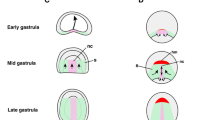Abstract.
Early work on the formation of the vertebrate body axis indicated the existence of separate head- and trunk-inducing regions in Spemann's organizer of the amphibian gastrula. In mammals some head-organizing activity may be located in anterior visceral (extraembryonic) endoderm (AVE). By analogy, the equivalent structure in the Xenopus laevis gastrula, the anterior endoderm, has been proposed to be the amphibian head organizer. Here we review recent data that challenge this notion and indicate that the involvement of AVE in head induction seems to be an exclusively mammalian characteristic. In X. laevis and chick, it is the prechordal endomesoderm that is the dominant source of head-inducing signals during early gastrulation. Furthermore, head induction in mammals needs a combination of signals from anterior primitive endoderm, prechordal plate, and anterior ectoderm. Thus, despite the homology of vertebrate anterior primitive endoderm, a role in head induction seems not to be conserved.
Similar content being viewed by others
Author information
Authors and Affiliations
Additional information
Electronic Publication
Rights and permissions
About this article
Cite this article
de Souza, F., Niehrs, C. Anterior endoderm and head induction in early vertebrate embryos. Cell Tissue Res 300, 207–217 (2000). https://doi.org/10.1007/s004410000204
Received:
Accepted:
Issue Date:
DOI: https://doi.org/10.1007/s004410000204




